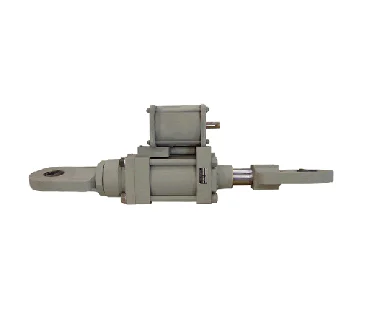What is Hydraulic Snubber?
Hydraulic Snubber is a device developed to protect high pressure/temperature piping system in power generating plants and various types of industrial plants mainly in Nuclear Industry. They function to restrain undesirable displacement of piping system or components when they are about to oscillate due to seismic or other types of dynamic loading, while, to allow their free movement during the thermal displacement mode. The hydraulic snubbers are designed to provide such essential two-way functions by means of a sophisticated combination of hydraulic cylinder with a valve mechanism. A built-in flexible reservoir is also a dominant design feature.

Operational Principle:
Hydraulic snubbers function by utilizing a piston within a hydraulic fluid-filled cylinder. Under normal conditions, the fluid allows the piston to move freely, accommodating slow movements due to thermal expansion or contraction. However, during sudden accelerations or shocks, the fluid’s resistance increases, causing the snubber to lock and restrain the movement, thereby protecting the piping system.
Technical Specifications:
- Size Range and Load Capacities:
- Hydraulic snubbers are available in various sizes, with cylinder bores typically ranging from 1.5 inches to 8 inches. These units can handle normal load ranges from approximately 3,000 lbs to 130,000 lbs. Standard stroke lengths include 6, 12, or 18 inches, depending on the specific model and manufacturer.
- Activation and Bleed Rates:
- Standard settings for activation (locking) velocity are around 8 ± 2 inches per minute. The bleed rate, which is the rate at which the snubber returns to its normal state post-activation under normal rated load, is typically 4 ± 1 inches per minute. These values can vary based on specific design requirements and operating conditions.
- Design Features:
- Many hydraulic snubbers incorporate durable metallic seals capable of withstanding internal pressures up to 1.5 times the standard operating levels. Spherical bearings are often fitted at each end of the snubber assembly to maintain the required stiffness and accommodate angular misalignments. Some models feature color-coded stroke indicators to facilitate easy in-service inspection.
- Material and Finish:
- Depending on the application environment, snubbers are available in standard and corrosion-resistant finishes. For instance, certain models offer a salt bath nitrided finish for enhanced corrosion resistance, while others may come with standard primer coatings.
Size Selection Guideline Selection of the proper snubber assembly shall be made based on the following design elements:
① Design dynamic load.
② Amount of Piston Displacement (calculated from pipe thermal travel) and its direction.
③ Overall installation length allotted for the snubber assembly.
④ Details of end conditions (Bracket or Pipe clamp).
⑤ Pipe size, material, and operating temparature, insulation thickness, if any.
Parts of Hydraulic Snubbers:
Hydraulic snubbers are critical components in piping systems, designed to control dynamic movements and protect against shock or seismic events. Proper installation and regular maintenance are essential to ensure their optimal performance and longevity. Below is a comprehensive guide outlining key procedures for the installation, inspection, and maintenance of hydraulic snubbers.

Hydraulic snubbers are used in various industries to control movement, absorb shock, and protect equipment from excessive forces. Here are some key applications:
1. Power Plants (Nuclear, Thermal, Hydro)
- Used in piping systems to prevent damage from thermal expansion, seismic events, and vibrations.
- Protects boilers, turbines, and heat exchangers from sudden shocks.
2. Petrochemical and Refinery Plants
- Prevents excessive movement in high-pressure pipelines due to pressure surges or seismic activities.
- Supports equipment subjected to dynamic loads.
3. Bridges and Civil Structures
- Used in bridges and buildings to absorb seismic forces and reduce structural damage.
- Helps control the movement of expansion joints.
4. Aerospace and Defense
- Used in aircraft landing gear systems to absorb shock during landing.
- Provides motion damping in military equipment and vehicles.
5. Industrial Machinery and Equipment
- Protects heavy rotating and reciprocating machinery from dynamic forces.
- Used in large industrial presses and mechanical systems to reduce vibrations.
6. Marine and Offshore Applications
- Used in ship structures and offshore oil rigs to absorb wave and wind-induced forces.
- Helps stabilize drilling platforms and cranes.
7. Railway and Transportation Systems
- Reduces vibrations in railway suspension systems.
- Provides stability to high-speed train components.
Image Source- Tekki Corp
https://neometrixgroup.com/products/dynamic-snubber-shock-arrestor-test-facility

